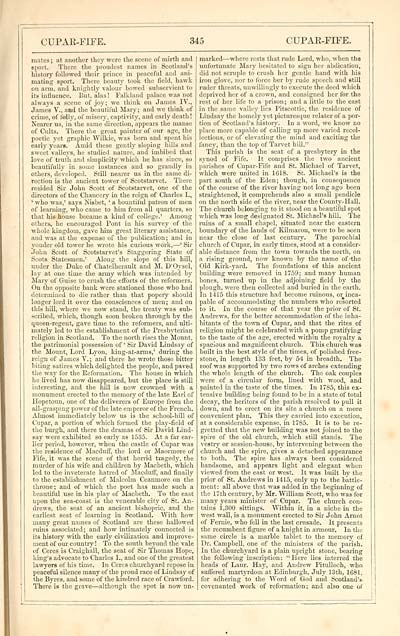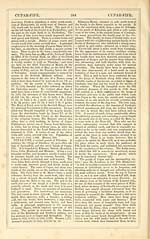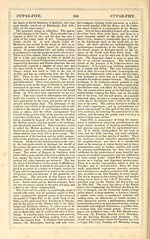Imperial gazeteer of Scotland, or, Dictionary of Scottish topography > Volume 1
(455) Page 345 - CUP
Download files
Complete book:
Individual page:
Thumbnail gallery: Grid view | List view

CUPAR-FIFE.
345
CUPAR-FIFE.
mates ; at another they were the scene of mirth anil
sport. There the proudest names in Scotland's
history followed their prince in peaceful and ani-
mating sport. There beauty took the field, hawk
on arm. and knightly valour bowed subservient to
its influence. But, alas! Falkland palace was not
always a scene of joy; we think on James IV.,
James V., and the beautiful Mary; and we think of
crime, of folly, of misery, captivity, and early death !
Nearer us, in the same direction, appears the manse
of Cults. There the great painter of our age, the
poetic yet graphic Wilkie, was born and spent bis
early years. Amid these gently sloping hills and
sweet valleys, he studied nature, and imbibed that
love of truth and simplicity which he has since, so
beautifully in some instances and so grandly in
others, developed. Still nearer us in the same di-
rection is the ancient tower of Scotstarvet. There
resided Sir John Scott of Scotstarvet, one of the
directors of the Chancery in the reign of Charles I.,
' who was,' says Nisbet, ' a bountiful patron of men
of learning, who came to him from all quarters, so
that his house hecame a kind of college.' Among
others, he encouraged Pont in his survey of the
whole kingdom, gave him great literary assistance,
and was at the expense of the publication; and in
yonder old tower he wrote his curious work, — ' Sir
John Scott of Scotstarvet's Staggering State of
Scots Statesmen.' Along the slope of this hill,
under the Duke of Chatelherault and M. D'Oysel,
lay at one time the army which was intended by
Mary of Guise to crush tie efforts of the reformers.
On the opposite bank were stationed those who had
determined to die rather than that popery should
longer lord it over the consciences of men; and on
this hill, where we now stand, the treaty was sub-
scribed, which, though soon broken through by the
queen-regent, gave time to the reformers, and ulti-
mately led to the establishment of the Presbyterian
religion in Scotland. To the north rises the Mount,
the patrimonial possession of ' Sir David Lindsay of
the Mount, Lord Lyon, king-at-arms,' during the
reign of James V.; and there he wrote those bitter
biting satires which delighted the people, and paved
the way for the Reformation. The house in which
he lived has now disappeared, but the place is still
interesting, and the hill is now crowned with a
monument erected to the memory of the late Earl of
Hopetoun, one of the deliverers of Europe from the
all-grasping power of the late emperor of the French.
Almost immediately below us is the school-hill of
Cupar, a portion of which formed the play-field of
the burgh, and there the dramas of Sir David Lind-
say were exhibited so early as 1535. At a far ear-
lier period, however, when the castle of Cupar was
the residence of Macduff, the lord or Maormore of
Fife, it was the scene of that horrid tragedy, the
murder of his wife and children by Macbeth, which
led to the inveterate hatred of Macduff, and finally
to the establishment of Malcolm Ceanmore on the
throne; and of which the poet has made such a
beautiful use in his play of Macbeth. To the east
upon the sea-coast is the venerable city of St. An-
drews, the seat of an ancient bishopric, and the
earliest seat of learning in Scotland. With how
many great names of Scotland are these hallowed
ruins associated; and how intimately connected is
its history with the early civilization and improve-
ment of our country ! To the south beyond the vale
of Ceres is Craighall, the seat of Sir Thomas Hope,
king's advocate to Charles I., and one of the greatest
lawyers of his time. In Ceres churchyard repose in
peaceful silence many of the proud race of Lindsay of
the Byres, and some of the kindred race of Crawford.
There isi the grave — although the spot is now un-
marked — where rests that rude Lord, who, when the
unfortunate Mary hesitated to sign her abdication,
did not scruple to crush her gentle hand with bis
iron glove, nor to force her by rude speech and still
ruder threats, unwillingly to execute the deed which
deprived her of a crown, and consigned her for the
rest of her life to a prison; and a little to the east
in the same valley lies Pitscottie, the residence of
Lindsay the homely yet picturesque relater of a por-
tion of Scotland's history. In a word, we know no
place more capable of calling up more varied recol-
lections, or of elevating the mind and exciting the
fancy, than the top of Tarvet hill."
This parish is the seat of a presbytery in the
synod of Fife. It comprises the two ancient
parishes of Cupar-Fife and St. Michael of Tarvet,
which were united in 1618. St. Michael's is the
part south of the Eden; though, in consequence
of the course of the river having not long ago been
straightened, it comprehends also a small pendicle
on the north side of the river, near the County-Hall.
The church belonging to it stood on a beautiful spot
which was long designated St. Michael's hill. The
linns of a small chapel, situated near the eastern
boundary of the lands of Kilmaron, were to be seen
near the close of last century. The parochial
church of Cupar, in early times, stood at a consider-
able distance from the town towards the north, on
a rising ground, now known by the name of -the
Old Kirk-yard. The foundations of this ancient
building were removed in 1759; and many human
bones, turned up in the adjoining field by the
plough, were then collected and buried in the earth.
In 1415 this structure had become ruinous, or inca-
pable of accommodating the numbers who resorted
to it. In the course of that year the prior of St.
Andrews, for the better accommodation of the inha-
bitants of the town of Cupar, and that the rites of
religion might be celebrated with a pomp gratifying
to the taste of the age, erected within the royalty a
spacious and magnificent church. This church was
built in the best style of the times, of polished free-
stone, in length 133 feet, by 54 in breadth. The
roof was supported by two rows of arches extending
the whole length of the church. The oak couples
were of a circular form, lined with wood, and
painted in the taste of the times. In 1785, this ex-
tensive building being found to be in a state of total
decay, the heritors of the parish resolved to pull it
down, and to erect on its site a church on a more
convenient plan. This they carried into execution,
at a considerable expense, in 1785. It is to be re-
gretted that the new building was not joined to the
spire of the old church, which still stands. The
vestry or session-house, by intervening between the
church and the spire, gives a detached appearance
to both. The spire has always been considered
handsome, and appears light and elegant when
viewed from the east or west. It was built by the
prior of St. Andrews in 1415, only up to the battle-
ment : all above that was added in the beginning of
the 17th century, by Mr. William Scott, who was for
many years minister of Cupar. The church con-
tains 1,300 sittings. Within it, in a niche in the
west wall, is a monument erected to Sir John Amot
of Fernie, who fell in the last crusade. It presents
the recumbent figure of a knight in armour. In the
same circle is a marble tablet to the memory of
Dr. Campbell, one of the ministers of the parish.
In the churchyard is a plain upright stone, bearing
the following inscription: "Here lies interred the
heads of Laur. Hay, and Andrew Pitulloch, who
suffered martyrdom at Edinburgh, July 13th, 1681.
for adhering to the AVord of God and Scotland's
covenanted work of reformation; and also one of
345
CUPAR-FIFE.
mates ; at another they were the scene of mirth anil
sport. There the proudest names in Scotland's
history followed their prince in peaceful and ani-
mating sport. There beauty took the field, hawk
on arm. and knightly valour bowed subservient to
its influence. But, alas! Falkland palace was not
always a scene of joy; we think on James IV.,
James V., and the beautiful Mary; and we think of
crime, of folly, of misery, captivity, and early death !
Nearer us, in the same direction, appears the manse
of Cults. There the great painter of our age, the
poetic yet graphic Wilkie, was born and spent bis
early years. Amid these gently sloping hills and
sweet valleys, he studied nature, and imbibed that
love of truth and simplicity which he has since, so
beautifully in some instances and so grandly in
others, developed. Still nearer us in the same di-
rection is the ancient tower of Scotstarvet. There
resided Sir John Scott of Scotstarvet, one of the
directors of the Chancery in the reign of Charles I.,
' who was,' says Nisbet, ' a bountiful patron of men
of learning, who came to him from all quarters, so
that his house hecame a kind of college.' Among
others, he encouraged Pont in his survey of the
whole kingdom, gave him great literary assistance,
and was at the expense of the publication; and in
yonder old tower he wrote his curious work, — ' Sir
John Scott of Scotstarvet's Staggering State of
Scots Statesmen.' Along the slope of this hill,
under the Duke of Chatelherault and M. D'Oysel,
lay at one time the army which was intended by
Mary of Guise to crush tie efforts of the reformers.
On the opposite bank were stationed those who had
determined to die rather than that popery should
longer lord it over the consciences of men; and on
this hill, where we now stand, the treaty was sub-
scribed, which, though soon broken through by the
queen-regent, gave time to the reformers, and ulti-
mately led to the establishment of the Presbyterian
religion in Scotland. To the north rises the Mount,
the patrimonial possession of ' Sir David Lindsay of
the Mount, Lord Lyon, king-at-arms,' during the
reign of James V.; and there he wrote those bitter
biting satires which delighted the people, and paved
the way for the Reformation. The house in which
he lived has now disappeared, but the place is still
interesting, and the hill is now crowned with a
monument erected to the memory of the late Earl of
Hopetoun, one of the deliverers of Europe from the
all-grasping power of the late emperor of the French.
Almost immediately below us is the school-hill of
Cupar, a portion of which formed the play-field of
the burgh, and there the dramas of Sir David Lind-
say were exhibited so early as 1535. At a far ear-
lier period, however, when the castle of Cupar was
the residence of Macduff, the lord or Maormore of
Fife, it was the scene of that horrid tragedy, the
murder of his wife and children by Macbeth, which
led to the inveterate hatred of Macduff, and finally
to the establishment of Malcolm Ceanmore on the
throne; and of which the poet has made such a
beautiful use in his play of Macbeth. To the east
upon the sea-coast is the venerable city of St. An-
drews, the seat of an ancient bishopric, and the
earliest seat of learning in Scotland. With how
many great names of Scotland are these hallowed
ruins associated; and how intimately connected is
its history with the early civilization and improve-
ment of our country ! To the south beyond the vale
of Ceres is Craighall, the seat of Sir Thomas Hope,
king's advocate to Charles I., and one of the greatest
lawyers of his time. In Ceres churchyard repose in
peaceful silence many of the proud race of Lindsay of
the Byres, and some of the kindred race of Crawford.
There isi the grave — although the spot is now un-
marked — where rests that rude Lord, who, when the
unfortunate Mary hesitated to sign her abdication,
did not scruple to crush her gentle hand with bis
iron glove, nor to force her by rude speech and still
ruder threats, unwillingly to execute the deed which
deprived her of a crown, and consigned her for the
rest of her life to a prison; and a little to the east
in the same valley lies Pitscottie, the residence of
Lindsay the homely yet picturesque relater of a por-
tion of Scotland's history. In a word, we know no
place more capable of calling up more varied recol-
lections, or of elevating the mind and exciting the
fancy, than the top of Tarvet hill."
This parish is the seat of a presbytery in the
synod of Fife. It comprises the two ancient
parishes of Cupar-Fife and St. Michael of Tarvet,
which were united in 1618. St. Michael's is the
part south of the Eden; though, in consequence
of the course of the river having not long ago been
straightened, it comprehends also a small pendicle
on the north side of the river, near the County-Hall.
The church belonging to it stood on a beautiful spot
which was long designated St. Michael's hill. The
linns of a small chapel, situated near the eastern
boundary of the lands of Kilmaron, were to be seen
near the close of last century. The parochial
church of Cupar, in early times, stood at a consider-
able distance from the town towards the north, on
a rising ground, now known by the name of -the
Old Kirk-yard. The foundations of this ancient
building were removed in 1759; and many human
bones, turned up in the adjoining field by the
plough, were then collected and buried in the earth.
In 1415 this structure had become ruinous, or inca-
pable of accommodating the numbers who resorted
to it. In the course of that year the prior of St.
Andrews, for the better accommodation of the inha-
bitants of the town of Cupar, and that the rites of
religion might be celebrated with a pomp gratifying
to the taste of the age, erected within the royalty a
spacious and magnificent church. This church was
built in the best style of the times, of polished free-
stone, in length 133 feet, by 54 in breadth. The
roof was supported by two rows of arches extending
the whole length of the church. The oak couples
were of a circular form, lined with wood, and
painted in the taste of the times. In 1785, this ex-
tensive building being found to be in a state of total
decay, the heritors of the parish resolved to pull it
down, and to erect on its site a church on a more
convenient plan. This they carried into execution,
at a considerable expense, in 1785. It is to be re-
gretted that the new building was not joined to the
spire of the old church, which still stands. The
vestry or session-house, by intervening between the
church and the spire, gives a detached appearance
to both. The spire has always been considered
handsome, and appears light and elegant when
viewed from the east or west. It was built by the
prior of St. Andrews in 1415, only up to the battle-
ment : all above that was added in the beginning of
the 17th century, by Mr. William Scott, who was for
many years minister of Cupar. The church con-
tains 1,300 sittings. Within it, in a niche in the
west wall, is a monument erected to Sir John Amot
of Fernie, who fell in the last crusade. It presents
the recumbent figure of a knight in armour. In the
same circle is a marble tablet to the memory of
Dr. Campbell, one of the ministers of the parish.
In the churchyard is a plain upright stone, bearing
the following inscription: "Here lies interred the
heads of Laur. Hay, and Andrew Pitulloch, who
suffered martyrdom at Edinburgh, July 13th, 1681.
for adhering to the AVord of God and Scotland's
covenanted work of reformation; and also one of
Set display mode to: Large image | Transcription
Images and transcriptions on this page, including medium image downloads, may be used under the Creative Commons Attribution 4.0 International Licence unless otherwise stated. ![]()
| Gazetteers of Scotland, 1803-1901 > Imperial gazeteer of Scotland, or, Dictionary of Scottish topography > Volume 1 > (455) Page 345 - CUP |
|---|
| Permanent URL | https://digital.nls.uk/97464590 |
|---|
| Description | Volume I: Aan-Gordon. |
|---|---|
| Attribution and copyright: |
|

